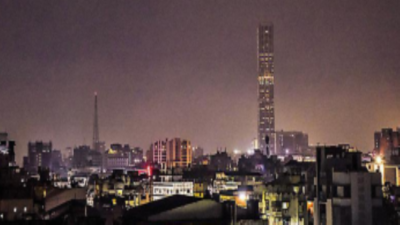Top Searches
- News
- City News
- kolkata News
- Dazzling Kolkata lights leave stargazers dazed
Dazzling Kolkata lights leave stargazers dazed

Light from LED street lamps envelops Kolkata’s night sky in white haze
KOLKATA: The bright city lights have blinded stargazers, prompting several of them to shift from Kolkata's rooftops to remote rural locations for the perfect view of the night sky.
The best season to star gaze is winter, between November and March, but it has become virtually impossible to watch the night sky from Kolkata with the white light from LED street lamps enveloping the city in diffused white haze, said sky watchers.
Nikhilesh Pal (64), who lives in Lake Town, has rented a room in Santiniketan to view the night sky. "I shifted all my telescopes, accessories and books related to astronomy to a small unit in Santiniketan, just to pursue my passion," he said.
Madhumita Rudra (34), who teaches geography in a government school, bought a 90mm Newtonian reflector telescope three months ago but has been unable to view the night sky from her Bhowanipore house due to the high light and air pollution.
"I now frequently travel during the weekends to our house in Bhadreswar where the sky is darker and we are able to observe planetary objects, like the nebula, galaxy and star clusters," she said. From the roof of her three-storey house, she is only able to view the moon surface, Jupiter, Saturn and the Pleiades star clusters.
Prabir Biswas (52), a Port Trust engineer from Netaji Nagar, attempted using expensive ultra high contrast and narrow band filters to remove the atmospheric haze during astrophotography. But it helped partially. Kolkata has a high presence of aerosol, and different atmospheric pollutants, like dust particles, gases and water vapour. Stargazers said the situation was much better before the switch from sodium vapour lamps to white LED.
Astrophysicist Debiprosad Duari said sky-lovers needed to get out of their comfort zone of terraces and travel far from the city to pursue their passion. "A city cannot be dark. One has to travel to greener pastures where the night sky is still clear to witness celestial objects and phenomena," said Duari, adding that a balance is required between rapid urbanisation and increase in inquisitiveness to observe the sky.
The quality of brightness of the night sky at any particular location is measured by a Bortle scale. There are nine levels and the range values vary between 1 to 9 - with 9 being the most amount of light pollution, which is usually found in the city centre.
"One will never be able to see the grandeur of the night sky, which we could view decades ago," said octogenarian Basudev Bhattacharyya, a retired physics professor who lives in Selimpur and is president of Skywatchers' Association, Kolkata.
Interestingly, at Hanle village of southwestern Ladakh, a dark sky reserve or night sky sanctuary has been planned for the first time in India to promote astro-tourism in the future.
The best season to star gaze is winter, between November and March, but it has become virtually impossible to watch the night sky from Kolkata with the white light from LED street lamps enveloping the city in diffused white haze, said sky watchers.
Nikhilesh Pal (64), who lives in Lake Town, has rented a room in Santiniketan to view the night sky. "I shifted all my telescopes, accessories and books related to astronomy to a small unit in Santiniketan, just to pursue my passion," he said.
Madhumita Rudra (34), who teaches geography in a government school, bought a 90mm Newtonian reflector telescope three months ago but has been unable to view the night sky from her Bhowanipore house due to the high light and air pollution.
"I now frequently travel during the weekends to our house in Bhadreswar where the sky is darker and we are able to observe planetary objects, like the nebula, galaxy and star clusters," she said. From the roof of her three-storey house, she is only able to view the moon surface, Jupiter, Saturn and the Pleiades star clusters.
Prabir Biswas (52), a Port Trust engineer from Netaji Nagar, attempted using expensive ultra high contrast and narrow band filters to remove the atmospheric haze during astrophotography. But it helped partially. Kolkata has a high presence of aerosol, and different atmospheric pollutants, like dust particles, gases and water vapour. Stargazers said the situation was much better before the switch from sodium vapour lamps to white LED.
Astrophysicist Debiprosad Duari said sky-lovers needed to get out of their comfort zone of terraces and travel far from the city to pursue their passion. "A city cannot be dark. One has to travel to greener pastures where the night sky is still clear to witness celestial objects and phenomena," said Duari, adding that a balance is required between rapid urbanisation and increase in inquisitiveness to observe the sky.
The quality of brightness of the night sky at any particular location is measured by a Bortle scale. There are nine levels and the range values vary between 1 to 9 - with 9 being the most amount of light pollution, which is usually found in the city centre.
"One will never be able to see the grandeur of the night sky, which we could view decades ago," said octogenarian Basudev Bhattacharyya, a retired physics professor who lives in Selimpur and is president of Skywatchers' Association, Kolkata.
Interestingly, at Hanle village of southwestern Ladakh, a dark sky reserve or night sky sanctuary has been planned for the first time in India to promote astro-tourism in the future.
Start a Conversation
FOLLOW US ON SOCIAL MEDIA
FacebookTwitterInstagramKOO APPYOUTUBE









